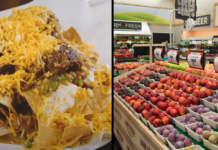The gradual increase of the minimum wage in Arizona is supposed to help those at the lower edge of pay scales, but it’s also impacting the bottom line of business owners.
Under Proposition 206, the so-called Fair Wages and Healthy Families Act, Arizona minimum wage increased from $8.05 to $10 per hour in 2017, then to $10.50 in 2018 and increased again to $11 per hour on Jan. 1.
In 2020, it will jump to $12.
“I feel like there’s nothing wrong with it,” said Antonio Gonzales, a senior at Maricopa High School who also works. “More money is more money, and it’s not that big of a jump like [$8.05] to $10 was. I think it’s a good change.”
Starting Jan. 1, 2021, the Arizona minimum wage will increase each year by the cost of living rate (or Consumer Price Index).
“Before that passed, we always took pride that we never started anybody at minimum wage,” said Mike Richey, owner of Maricopa Ace Hardware. “Today we have to start at minimum wage pretty much defensively because of how fast the rise (in minimum wage) is. When you couple that with some of the issues with margin and prices, especially with what’s happening with tariffs because everything comes out of China, it has an accumulative effect.”
Voters approved the increases 58 percent to 41 percent in 2016, but even those who benefit from the increase are divided about the issue.
“That’s more money for me to pay for college and stuff,” said Kamille Boyce, a Denny’s employee and a junior at Maricopa High School.
“I don’t think it’s a good idea,” said fellow MHS junior Douglas Moulton. “When minimum wage goes up, people can stay at a minimum-wage job and never better themselves. It makes people lazy.”
One of the hurdles in this scenario is businesses cutting costs. Big-box stores have numerous self-checkout lines, eliminating the need for cashiers. Fast-food restaurants are installing touch-screen ordering systems that don’t involve an employee in the order-taking process.
Employers are finding creative ways to eliminate higher paychecks and, ultimately, jobs.
Richey said the set increases are not the big problem looming on the horizon. He worries about what will happen when minimum wage is tied to the cost-of-living index.
“My concern is the tariffs that we’re looking at now may well cause an increase in the CPI (Consumer Price Index), and now we’re dealing with CPI increases on wages and not just a fixed amount,” Richey said.
He said he’s not ready to say his company will be hiring fewer employees because of the wage hikes.
“Service levels are key to our business. It is not something that we are considering at this point. Once we start looking at CPI and it’s not a moderate increase, we’d have to consider it at that time,” Richey said.
He added while big-box stores have self-checkouts and fast food has touch-screen ordering systems, “It’s not going to happen here. Service is king. It is what we do. It is how we identify ourselves.”
With minimum wage increases after 2021 tied to the CPI, wage increases “go on forever. If we can’t settle this thing with China and the CPI goes up by 12 percent, it’s going to be tough on businesses.”
The food service industry has been hit hard by increases in minimum wage.
Pat Kieny, owner of Native Grill and Wings in Maricopa, said, “This is the third time we’ve been though it in the last three years. It’s not as much. The initial one had the largest effect. We always have to plan to price ourselves right between the ability to earn money running a business and paying the increased costs that the minimum wage brings.”
He said the increases are leading to fewer and fewer employees to cover shifts.
“We mostly try to keep our turnover really low and have highly experienced people. They are twice to three times as good as new employees. Which is our case in Maricopa. We have lots of veteran employees. So, it doesn’t affect us as much here as it does in some of the other restaurants throughout the Valley,” Kieny said.
Five of his servers/bartenders are former managers with Native.
“They know everything, and it is just awesome to have them,” he said, adding Native corporate offices are looking at integrating technology into the restaurant to decrease costs.
“We are less likely to do that because the full-service restaurant industry has a lot of interaction between the employees and the customer. We are more likely to buy some things that are more pre-prepared on the food side of the business,” he said.
Kieny said adding more sales is the best way to cover increasing costs.
“Everything always goes up,” Kieny said. “The rent goes up. Labor costs go up. Food cost over a 10-year period is pretty equal but you can have spikes. With all the bad stuff going on, it’s really great to have positive feelings I get from working with people in Maricopa.”
This story appears in the January issue of InMaricopa.




![Alleged car thief released without charges Phoenix police stop a stolen vehicle on April 20, 2024. [Facebook]](https://www.inmaricopa.com/wp-content/uploads/2024/04/IMG_5040-218x150.jpg)
![Locals find zen with Earth Day drum circle Lizz Fiedorczyk instructs a drum circle at Maricopa Community Center April 22, 2024. [Brian Petersheim Jr.]](https://www.inmaricopa.com/wp-content/uploads/2024/04/PJ_3922-Enhanced-NR-218x150.jpg)










![Alleged car thief released without charges Phoenix police stop a stolen vehicle on April 20, 2024. [Facebook]](https://www.inmaricopa.com/wp-content/uploads/2024/04/IMG_5040-100x70.jpg)
![Locals find zen with Earth Day drum circle Lizz Fiedorczyk instructs a drum circle at Maricopa Community Center April 22, 2024. [Brian Petersheim Jr.]](https://www.inmaricopa.com/wp-content/uploads/2024/04/PJ_3922-Enhanced-NR-100x70.jpg)